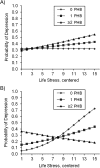Reconsidering the role of social disadvantage in physical and mental health: stressful life events, health behaviors, race, and depression
- PMID: 20884682
- PMCID: PMC3025628
- DOI: 10.1093/aje/kwq283
Reconsidering the role of social disadvantage in physical and mental health: stressful life events, health behaviors, race, and depression
Abstract
Prevalence of depression is associated inversely with some indicators of socioeconomic position, and the stress of social disadvantage is hypothesized to mediate this relation. Relative to whites, blacks have a higher burden of most physical health conditions but, unexpectedly, a lower burden of depression. This study evaluated an etiologic model that integrates mental and physical health to account for this counterintuitive patterning. The Baltimore Epidemiologic Catchment Area Study (Maryland, 1993-2004) was used to evaluate the interaction between stress and poor health behaviors (smoking, alcohol use, poor diet, and obesity) and risk of depression 12 years later for 341 blacks and 601 whites. At baseline, blacks engaged in more poor health behaviors and had a lower prevalence of depression compared with whites (5.9% vs. 9.2%). The interaction between health behaviors and stress was nonsignificant for whites (odds ratio (OR = 1.04, 95% confidence interval: 0.98, 1.11); for blacks, the interaction term was significant and negative (β: -0.18, P < 0.014). For blacks, the association between median stress and depression was stronger for those who engaged in zero (OR = 1.34) relative to 1 (OR = 1.12) and ≥2 (OR = 0.94) poor health behaviors. Findings are consistent with the proposed model of mental and physical health disparities.
Figures
Comment in
-
Re.: "Reconsidering the role of social disadvantage in physical and mental health: stressful life events, health behaviors, race, and depression".Am J Epidemiol. 2011 Jun 1;173(11):1348-9; author reply 1349-51. doi: 10.1093/aje/kwr110. Epub 2011 May 3. Am J Epidemiol. 2011. PMID: 21540321 Free PMC article. No abstract available.
References
-
- Williams DR, Collins C. US socioeconomic and racial differences in health: patterns and explanations. Ann Rev Sociol. 1995;21:349–386.
-
- DeNavas-Walt C, Proctor BD, Smith JC. Income, Poverty, and Health Insurance Coverage in the United States: 2008. US Census Bureau, Current Population Reports, P60-236. Washington, DC: US Government Printing Office; 2009.
-
- Mensah GA, Mokdad AH, Ford ES, et al. State of disparities in cardiovascular health in the United States. Circulation. 2005;111(10):1233–1241. - PubMed
-
- Lantz PM, Lynch JW, House JS, et al. Socioeconomic disparities in health change in a longitudinal study of US adults: the role of health-risk behaviors. Soc Sci Med. 2001;53(1):29–40. - PubMed
Publication types
MeSH terms
Grants and funding
- U01-MH57716/MH/NIMH NIH HHS/United States
- 1T32 MH67555/MH/NIMH NIH HHS/United States
- T32 MH067555/MH/NIMH NIH HHS/United States
- U01 MH057716/MH/NIMH NIH HHS/United States
- P01 MH058565/MH/NIMH NIH HHS/United States
- 5 R01 AG020282-04/AG/NIA NIH HHS/United States
- P30 AG015281/AG/NIA NIH HHS/United States
- 1 P60 MD002249-01/MD/NIMHD NIH HHS/United States
- R01 DA026652/DA/NIDA NIH HHS/United States
- P60 MD002249/MD/NIMHD NIH HHS/United States
- 1P01 MH58565/MH/NIMH NIH HHS/United States
- R01 AG020282/AG/NIA NIH HHS/United States
LinkOut - more resources
Full Text Sources
Medical


